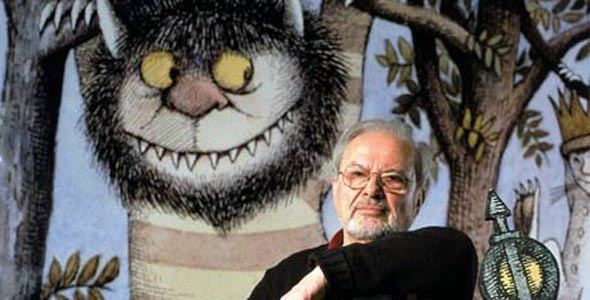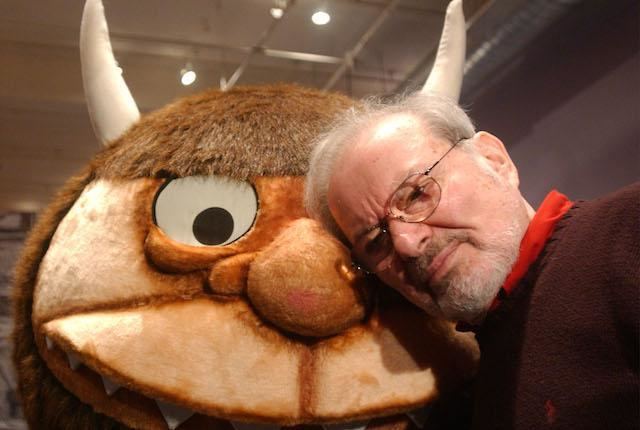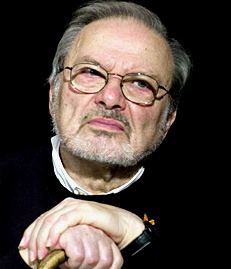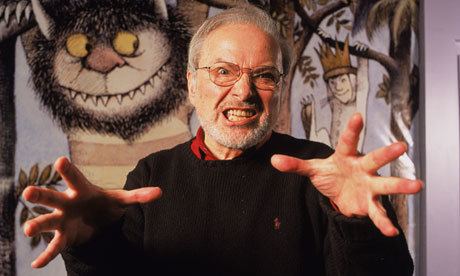Resting place Cremated Role Illustrator Name Maurice Sendak | Period 1947–2012 Nationality American | |
Born Maurice Bernard SendakJune 10, 1928Brooklyn, New York, USA ( 1928-06-10 ) Occupation Artist, illustrator, writer Genre Children's literature, picture books Parents Sadie Schindler, Philip Sendak Books Where the Wild Things Are, In the Night Kitchen, Outside Over There, Chicken Soup with Rice, Bumble Ardy Similar People | ||
Now on pbs interview with maurice sendak
Maurice Bernard Sendak (; June 10, 1928 – May 8, 2012) was an American illustrator and writer of children's books. He became widely known for his book Where the Wild Things Are, first published in 1963. Born to Jewish-Polish parents, his childhood was affected by the death of many of his family members during the Holocaust. Sendak also wrote works such as In the Night Kitchen, Outside Over There, and illustrated many works by other authors including the Little Bear books by Else Holmelund Minarik.
Contents
- Now on pbs interview with maurice sendak
- An Illustrated Talk With Maurice Sendak The New York Times
- Early life
- Work
- Personal life
- Influences
- Death
- Maurice Sendak Collection
- Awards and honors
- Author
- Illustrator
- Collections
- Filmography
- Selected exhibitions
- References

An Illustrated Talk With Maurice Sendak | The New York Times
Early life

Sendak was born in Brooklyn, New York to Polish Jewish immigrant parents named Sadie (née Schindler) and Philip Sendak, a dressmaker. Sendak described his childhood as a "terrible situation" due to the death of members of his extended family during the Holocaust which exposed him at a young age to the concept of mortality. His love of books began when, as a child, he developed health problems and was confined to his bed. He decided to become an illustrator after watching Walt Disney's film Fantasia at the age of twelve. One of his first professional commissions was to create window displays for the toy store FAO Schwarz. His illustrations were first published in 1947 in a textbook titled Atomics for the Millions by Maxwell Leigh Eidinoff. He spent much of the 1950s illustrating children's books written by others before beginning to write his own stories.

His older brother Jack Sendak also became an author of children's books, two of which were illustrated by Maurice in the 1950s.

Maurice was the youngest of three siblings. His sister, Natalie, was nine years older than he, and his brother, Jack, was five years older than him.
Work
Sendak gained international acclaim after writing and illustrating Where the Wild Things Are, edited by Ursula Nordstrom at Harper & Row. It features Max, a boy who "rages against his mother for being sent to bed without any supper". The book's depictions of fanged monsters concerned some parents when it was first published, as his characters were somewhat grotesque in appearance. Before Where the Wild Things Are, Sendak was best known for illustrating Else Holmelund Minarik's Little Bear series of books.
Sendak later recounted the reaction of a fan:
A little boy sent me a charming card with a little drawing on it. I loved it. I answer all my children's letters – sometimes very hastily – but this one I lingered over. I sent him a card and I drew a picture of a Wild Thing on it. I wrote, 'Dear Jim: I loved your card.' Then I got a letter back from his mother and she said: 'Jim loved your card so much he ate it.' That to me was one of the highest compliments I've ever received. He didn't care that it was an original Maurice Sendak drawing or anything. He saw it, he loved it, he ate it.
Almost fifty years later, School Library Journal sponsored a survey of readers which identified Where the Wild Things Are as a top picture book. The librarian who conducted it observed that there was little doubt what would be voted number one and highlighted its designation by one reader as a watershed, "ushering in the modern age of picture books". Another called it "perfectly crafted, perfectly illustrated ... simply the epitome of a picture book" and noted that Sendak "rises above the rest in part because he is subversive".
When Sendak saw a manuscript of Zlateh the Goat and Other Stories, the first children's book by Isaac Bashevis Singer, on the desk of an editor at Harper & Row, he offered to illustrate the book. It was first published in 1966 and received a Newbery Honor. Sendak was delighted and enthusiastic about the collaboration. He once wryly remarked that his parents were "finally" impressed by their youngest child when he collaborated with Singer.
His book In the Night Kitchen, originally issued in 1970, has often been subjected to censorship for its drawings of a young boy prancing naked through the story. The book has been challenged in several American states including Illinois, New Jersey, Minnesota, and Texas. In the Night Kitchen regularly appears on the American Library Association's list of "frequently challenged and banned books". It was listed number 21 on the "100 Most Frequently Challenged Books of 1990–1999".
His 1981 book Outside Over There is the story of a girl, Ida, and her sibling jealousy and responsibility. Her father is away and so Ida is left to watch her baby sister, much to her dismay. Her sister is kidnapped by goblins and Ida must go off on a magical adventure to rescue her. At first, she is not really eager to get her sister and nearly passes her sister right by when she becomes absorbed in the magic of the quest. In the end, she rescues her baby sister, destroys the goblins, and returns home committed to caring for her sister until her father returns home.
Sendak was an early member of the National Board of Advisors of the Children's Television Workshop during the development stages of the Sesame Street television series. He also adapted his book Bumble Ardy into an animated sequence for the series, with Jim Henson as the voice of Bumble Ardy. He wrote and designed three other animated stories for the series: Seven Monsters (which never aired), Up & Down, and Broom Adventures.
Sendak produced an animated television production based on his work titled Really Rosie, featuring the voice of Carole King, which was broadcast in 1975 and is available on video (usually as part of video compilations of his work). An album of the songs was also produced. He contributed the opening segment to Simple Gifts, a Christmas collection of six animated shorts shown on PBS TV in 1977 and later issued on VHS in 1993. He adapted his book Where the Wild Things Are for the stage in 1979. Additionally, he designed sets for many operas and ballets, including the award-winning (1983) Pacific Northwest Ballet production of Tchaikovsky's The Nutcracker, Houston Grand Opera's productions of Mozart's The Magic Flute (1981) and Humperdinck's Hansel and Gretel (1997), Los Angeles County Music Center's 1990 production of Mozart's Idomeneo, and the New York City Opera's 1981 production of Janáček's The Cunning Little Vixen.
In the 1990s, Sendak approached playwright Tony Kushner to write a new English version of the Czech composer Hans Krása's children's Holocaust opera Brundibár. Kushner wrote the text for Sendak's illustrated book of the same name, published in 2003. The book was named one of The New York Times Book Review's 10 Best Illustrated Books of 2003.
In 2003, Chicago Opera Theatre produced Sendak and Kushner's adaptation of Brundibár. In 2005, Berkeley Repertory Theatre, in collaboration with Yale Repertory Theatre and Broadway's New Victory Theater, produced a substantially reworked version of the Sendak-Kushner adaptation.
In 2004 Sendak worked with the Shirim Klezmer Orchestra in Boston on their project Pincus and the Pig: A Klezmer Tale. This Klezmer version of Sergei Prokofiev's famous musical story for children, Peter and the Wolf featured Maurice Sendak as the narrator. He also illustrated the cover art.
Sendak also created the children's television program Seven Little Monsters.
Personal life
Sendak mentioned in a September 2008 article in The New York Times that he was gay and had lived with his partner, psychoanalyst Eugene Glynn, for 50 years before Glynn's death in May 2007. Revealing that he never told his parents, he said, "All I wanted was to be straight so my parents could be happy. They never, never, never knew." Sendak's relationship with Glynn had been mentioned by other writers before (e.g., Tony Kushner in 2003) and Glynn's 2007 death notice had identified Sendak as his "partner of fifty years". After his partner's death, Sendak donated $1 million to the Jewish Board of Family and Children's Services in memory of Glynn who had treated young people there. The gift will name a clinic for Glynn.
Sendak was an atheist. In a 2011 interview, he stated that he did not believe in God and explained that he felt that religion, and belief in God, "must have made life much easier [for some religious friends of his]. It's harder for us non-believers."
Influences
Maurice Sendak drew inspiration and influences from a vast number of painters, musicians, and authors. Going back to his childhood, one of his earliest memorable influences was actually his father, Philip Sendak. According to Maurice, his father would relate tales from the Torah; however, he would embellish them with racy details. Not realizing that this was inappropriate for children, little Maurice would frequently be sent home after retelling his father's "softcore Bible tales" at school.
Growing up, Sendak developed from other influences, starting with Walt Disney's Fantasia and Mickey Mouse. Sendak and Mickey Mouse were born in the same year and Sendak described Mickey as a source of joy and pleasure while growing up. He has been quoted as saying, "My gods are Herman Melville, Emily Dickinson, Mozart. I believe in them with all my heart." Elaborating further, he has explained that reading Emily Dickinson's works helps him to remain calm in an otherwise hectic world: "And I have a little tiny Emily Dickinson so big that I carry in my pocket everywhere. And you just read three poems of Emily. She is so brave. She is so strong. She is such a passionate little woman. I feel better." Likewise, of Mozart, he has said, "When Mozart is playing in my room, I am in conjunction with something I can't explain. [...] I don't need to. I know that if there's a purpose for life, it was for me to hear Mozart."
Ursula Nordstrom, director of Harper's Department of Books for Boys and Girls from 1940 to 1973, was also an inspiration for Sendak.
Death
Sendak died on May 8, 2012, at age 83, in Danbury, Connecticut, at Danbury Hospital, from complications of a stroke, less than a month before his 84th birthday. His remains were cremated.
The New York Times obituary called Sendak "the most important children's book artist of the 20th century." Author Neil Gaiman remarked, "He was unique, grumpy, brilliant, wise, magical and made the world better by creating art in it." Author R. L. Stine called Sendak's death "a sad day in children's books and for the world."
Comedian Stephen Colbert, who interviewed Sendak in one of his last public appearances on his TV program The Colbert Report, said of the author: "We are all honored to have been briefly invited into his world." Sendak's appearance on a January 2012 episode of The Colbert Report saw him teach Colbert how to illustrate and provide a book blurb for Colbert's own children's book, I Am a Pole (And So Can You!), and the day that Sendak died was also the book's official release date.
The 2012 season of Pacific Northwest Ballet's The Nutcracker, for which Sendak designed the set, was dedicated to his memory.
On May 12, 2012, Nick Jr. hosted a 2-hour Little Bear marathon in his memory. The writer of the series Else Holmelund Minarik would die herself only two months later on July 12, 2012, at the age of 91.
His final book, Bumble-Ardy, was published eight months before his death. A posthumous picture book, titled My Brother's Book, was published in February 2013.
The film Her was dedicated in memory of him and Where the Wild Things Are co-star James Gandolfini. The film was directed by Spike Jonze, who also directed the motion picture adaptation of Where the Wild Things Are.
Maurice Sendak Collection
In 1968 Sendak loaned the Rosenbach Museum & Library in Philadelphia, Pennsylvania, the bulk of his work including nearly 10,000 works of art, manuscripts, books and ephemera. From May 6, 2008, through May 3, 2009, the Rosenbach presented There's a Mystery There: Sendak on Sendak. This major retrospective of over 130 pieces pulled from the museum's vast Sendak collection featured original artwork, rare sketches, never-before-seen working materials, and exclusive interview footage.
Exhibition highlights included the following:
Since the items had been on loan to the Rosenbach for decades, many in the museum world expected that the Sendak material would remain there. But Mr. Sendak’s will specified that the drawings and most of the loans would remain the property of the Maurice Sendak Foundation. In 2014, representatives of his estate withdrew the works, saying they intended to follow Mr. Sendak’s directive in his will to create “a museum or similar facility” in Ridgefield, Conn., where he lived, and where his foundation is based, “to be used by scholars, students, artists, illustrators and writers, and to be opened to the general public” as the foundation’s directors saw fit.
The Rosenbach filed an action in 2014 in state probate court in Connecticut, contending that the estate had kept many rare books that Mr. Sendak had pledged to the library in his will. In a ruling in Connecticut probate court, a judge awarded the bulk of the disputed book collection to the Sendak estate, not to the museum.
Awards and honors
Internationally, Sendak received the third biennial Hans Christian Andersen Award for Illustration in 1970, recognizing his "lasting contribution to children's literature". He received one of two inaugural Astrid Lindgren Memorial Awards in 2003, recognizing his career contribution to "children's and young adult literature in the broadest sense". The citation called him "the modern picture-book's portal figure" and the presentation credited Where the Wild Things Are with "all at once [revolutionizing] the entire picture-book narrative ... thematically, aesthetically, and psychologically." In the U.S. he received the Laura Ingalls Wilder Medal from the professional children's librarians in 1983, recognizing his "substantial and lasting contributions to children's literature". At the time it was awarded every three years. Only Sendak and the writer Katherine Paterson have won all three of these premier awards.
Sendak has two elementary schools named in his honor, one in North Hollywood, California, and PS 118 in Brooklyn, New York. He received an honorary doctorate from Princeton University in 1984.
On June 10, 2013, Google featured an interactive doodle where visitors could click on the video go triangle to see an animated movie-ette of Max and Sendak's other main characters.
